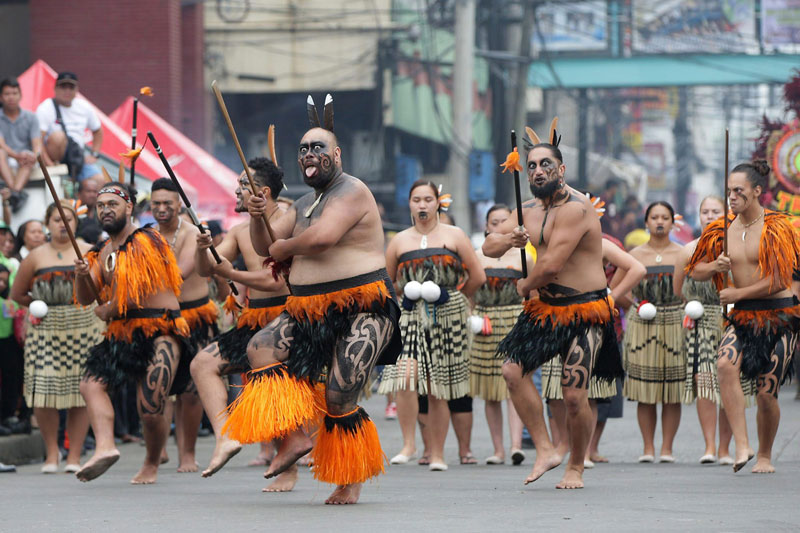Dinagyang at 50

Dinagyang is considered one of the most exciting of all street dance festivals. Two highly-contested competitions are at the center of the festivities – the Kasadyahan Cultural Competition and the Dinagyang Ati Dance Competition.
Manila, Philippines — If there is one event the Ilonggos of Iloilo City take great pride in, it’s the annual Dinagyang Festival. During the last week of January, the city comes alive with the pulsating beat of “Hala bira, Iloilo!” accompanying exciting festival activities that showcase local color and artistry, and thousands of residents and tourists swarming the streets to join the fun.
Almost everyone has some form of involvement in the festival – as organizer, as sponsor, as participant, as vendor or as spectator. It may not be as big as the Sinulog Festival of Cebu but the Dinagyang certainly bears the stamp of ownership that Ilonggos are truly proud of.
This year, the festival celebrated its 50th anniversary with great fanfare and aplomb. After all, being one of the oldest continuing festivals in the country is an honor by itself. Aside from the Ati-atihan (about 800 years old) and the Moriones (130 years old), Dinagyang is more senior than most of the more prominent festivals like the Kaamulan of Malaybalay (now on its 43rd year), Sinulog and Lanzones of Camiguin (38th year), Masskara of Bacolod (37th year), Kadayawan of Davao and Pintados of Leyte (31st year), and the Panagbenga of Baguio (21st year).
The Dinagyang traces its roots to 1968 when a replica of the image of the Sto. Niño of Cebu was donated to the San Jose Parish Church by Fr. Sulpicio Enderes of Cebu. The following year, the 1st feast of the Sto. Niño was celebrated in Iloilo City with a procession and a fluvial parade. A performance of Kalibo’s Ati-atihan Festival champion, Black Beauty, and the festival competition’s 1st runner-up kicked off the staging of the first Iloilo Dinagyang Festival.
In essence therefore, the Dinagyang was born out of the religious legacy of Cebu and the festivities of Kalibo. But through the years, it has evolved into a unique festival with its own character that reflects the vibrancy of the Ilonggo culture. The term “dinagyang” which means merrymaking, carries with it the distinct brand of the Ilonggos’ hospitality and fun-loving nature.
To celebrate this golden milestone, the Iloilo Dinagyang Foundation, headed by Chairman Ramon Cua Locsin, and the Iloilo City government, headed by Mayor Jose S. Espinosa III, mounted a month-long festival in partnership with various government and private organizations.
As part of the 50-year tradition, the core of the festivities were the fluvial and foot processions held every fourth Friday of January. Bearing the Sto. Niño icon, the flotilla of boats sailed down the Iloilo River from Fort San Pedro to the pier fronting the Aduana. This was followed by a foot procession to the San Jose Parish Church.
The festival activities included the Dinagyang Regional Trade Fair organized by the Philippine Chamber of Commerce – Iloilo chapter at SM City Iloilo; the Miss Iloilo Dinagyang pageant; Pamukaw 3, a visual arts exhibit featuring works by established and upcoming Ilonggo visual artists at SM City; the Dinagyang Food Festival organized by the Iloilo Hotel, Restaurant and Resort Association; Glitters in the Sky, a grand fireworks display; and the Sponsors’ Mardi Gras, a parade with dance and float competitions among Iloilo’s business establishments.
Of course, there were the usual rave parties for millennials held in several public areas in the city. If you’re not used to pulsating, ear-splitting music, avoid staying in a hotel near these areas because they usually last up to the wee hours of the morning.
There were two interesting events that were held for the first time – the 1st Dinagyang Float and Lights Parade which was held in the evening of Jan. 27. Around 50 floats with stunning lighting effects participated in the parade and competition. The other cultural event was the 1st Dinagyang International Cultural Night organized by Annie Sartorio and Eric Divinagracia on Jan. 26. Dance and music performances from New Zealand, South Korea, Hawaii, Spain, China and the Philippines wowed the capacity crowd at SM City Iloilo.
The highlight of the festival was the two highly-contested street dance competitions that have made the Dinagyang one of the most exciting among the Philippines’ 627 festivals. These were the Kasadyahan Cultural Competition and the Dinagyang Ati Dance Competition. The Kasadyahan is a region-wide competition of festival winners from West Visayas showcasing veneration of the Sto. Niño. This year’s winner was Hubon Mangunguma from Camiguin which showcased the rice and mango production of San Lorenzo. The Ati Dance Competition meanwhile was won by Tribu Panayanon of the Iloilo City National High School, a three-time champion from 2013 to 2015.
From an artistic standpoint, one could say that the Dinagyang is the most exciting of all the street dance festivals in the country. It has evolved from the original Ati-atihan style into a sophisticated dance form with fast-paced choreography, energetic performances, precision steps, and engaging musical accompaniment.
This year’s Golden Dinagyang encapsulated the evolution of the festival from its simple beginnings in 1968. As Locsin sums it up, “Dinagyang represents Ilonggo unity for progress and development through faith in action.”
He adds, “It underlines the richness of Ilonggo history and highlights the resiliency of Ilonggos which makes us stronger with every test and enables us to move forward with the ever-changing scenarios.”
- Latest
- Trending


















